1.2 Evidence of Evolution
The evidence for evolution is compelling and extensive. Looking at every level of organization in living systems, biologists see the signature of past and present evolution. Darwin dedicated a large portion of his book, On the Origin of Species, to identifying patterns in nature that were consistent with evolution, and since Darwin, our understanding has become clearer and broader (Darwin, 2009).
Evidence of evolution can be divided into five main categories:
1. Fossils
Fossils are the preserved remains or traces of organisms that lived in the remote past (over 10,000 years ago). Many different types of fossils occur in various stages of completeness, collectively forming the fossil record, which provides a wealth of information about evolution (Figure 1.2.1).

Fossils provide solid evidence that organisms from the past are not the same as those found today; fossils show a progression of evolution. Scientists determine the age of fossils and categorize them all over the world to determine when the organisms lived relative to each other. The resulting fossil record tells the story of the past and shows the evolution of form over millions of years (Figure 1.2.2). For example, highly detailed fossil records have been recovered for sequences of species in the evolution of whales and modern horses.
The fossil record of horses in North America is especially rich, and many contain transition fossils: those showing intermediate anatomy between earlier and later forms. The fossil record extends back to a dog-like ancestor some 55 million years ago that gave rise to the first horse-like species 55 to 42 million years ago in the genus Eohippus. The series of fossil tracks shows the change in anatomy resulting from a gradual drying trend that changed the landscape from a forested one to a prairie. Successive fossils show the evolution of tooth shapes and foot and leg anatomy to a grazing habit, with adaptations for escaping predators, for example, in species of Mesohippus found from 40 to 30 million years ago. Later species showed gains in size, such as those of Hipparion, which existed from about 23 to 2 million years ago. The fossil record shows several adaptive radiations in the horse lineage, which is now much reduced to only one genus, Equus, with several species.

2. Comparative Anatomy
Related organisms have similar bodily structures or anatomy; for example, the skeletons of humans, cats, and bats are similar, despite numerous obvious differences. There is a bone-by-bone similarity in the bodies of these three animals. Anatomical similarities are particularly evident in a comparison of the forelimbs (Figure 1.2.3). These animals live in different types of environments and use their limbs for different functions–flying, swimming, or grasping and throwing. Despite these different functions, all of these animals possess limbs with certain shared characteristics: a five-digit structure, a single large bone (humerus), two bones in the forearm (ulna and radius), and several wrist bones. These bones are homologous to each other; that is, they were inherited from a common ancestor.
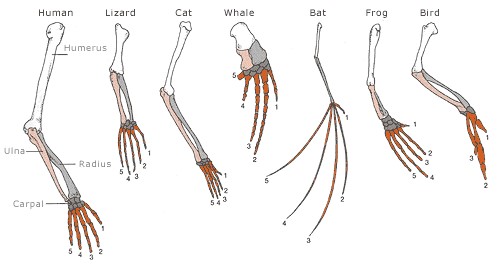
All four-limbed animals (or tetrapods)–amphibians, reptiles, birds, and mammals–have similar limbs. Anatomical similarities, such as those that characterize tetrapod limbs, are used as evidence for common ancestry. In other words, these similarities suggest that birds, bats, whales, and humans all share a common ancestor somewhere in their distant past. Learning about shared ancestry provides an important clue to understanding an organism’s evolution.
Homologous Structures
Homologous structures, or homologies, are anatomical features that different organisms share as a result of a common ancestor. The tetrapod limbs discussed above are homologous. Because they evolved from an ancestor and are currently shared by different organisms, homologies are often called shared derived traits. Cactus spines, the leaves of a maple tree, and the cup-like “pitcher” of a pitcher plant are all modified from a common structure in an ancestor shared by all leaf-bearing land plants. While these leaves look different and have evolved to serve different purposes, they are homologous structures and tell important stories about each plant’s history (Figure 1.2.4). These differences are the result of divergent evolution, where species with a common ancestor evolve distinct traits in response to different environmental pressures.

Analogous Structures
Analogous structures, or analogies, are anatomical features that different types of organisms share, but not as a result of a shared ancestor. Instead, analogies are similar because the organisms have changed in response to similar environments. When distantly related organisms share features as a result of similar environmental pressures (and not because of common ancestry), we say that they have undergone convergent evolution. For example, arctic mammals such as foxes and snowshoe hares grow white fur during the winter months. White fur allows these organisms to blend into the ice and snow that characterizes their polar home and presumably protects them from predation. Foxes and snowshoe hares, however, do not share a common ancestor with white fur. Of course, they ultimately share a common ancestor, as do all mammals, but the fox lineage is full of non-white animals, as is the group to which hares belong. The winter white of arctic foxes and snowshoe hares is thus an analogous structure, resulting from convergent evolution in a white, wintry landscape.
Vestigial Structures
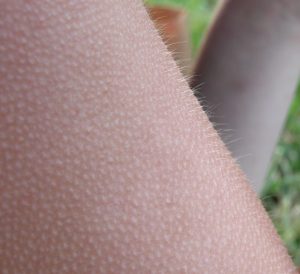
Vestigial structures are anatomical features that are either no longer in use or have a use which has been greatly reduced or altered. Vestigial structures provide clues to an organism’s history by suggesting what features were useful in the past, and by linking an organism to other, related organisms. For example, many mammals exhibit piloerection, whereby muscles constrict around the hair follicles and the animal’s hair stands on end. If you’ve ever surprised or otherwise threatened a dog or cat, you’ve probably seen the results of piloerection. Humans are mammals too, but we’ve been reduced to a scant covering of body hair. When we are scared, we also constrict the muscles around our hair follicles, but this just gives us goosebumps (Figure 1.2.5). Goosebumps aren’t very scary, but as vestigia, they link us to our mammalian relatives and tell us something about our evolutionary history.
3. Biogeography
Biogeography, the study of the distribution of living organisms, addresses several evolutionary questions: How many types of organisms exist? Why are some types of organisms (e.g. insects) more abundant than others (e.g. mammals)? Why do certain organisms live in some places and not others? Why do islands have such distinct biodiversity compared to the larger continents? Why aren’t there any polar bears in Antarctica? Why aren’t there any giraffes in Hawaii? And so on….

Likewise, an understanding of evolution helps us appreciate the otherwise perplexing global distribution of marsupial mammals (Figure 1.2.6). Marsupials are mammals in which females transport their young in distinctive pouches throughout their early infancy. In contrast, placental mammals have placental gestation and young that are born at a more developed stage. Marsupial mammals, such as kangaroos, opossums, wombats, and wallabies, occur in North and South America, Australia, and New Guinea, whereas the more numerous placental mammals dominate the rest of the world. How can we explain these odd distribution patterns?
Knowledge of Earth’s history is key to biogeography and evolutionary understanding. Indeed, a consideration of continental drift—the movement of the continents, over geologic time, as a result of the movement of plates in Earth’s crust (discussed in more depth in 3.1)—is necessary to understand marsupial biogeography (Figure 1.2.7). We also know, from fossil evidence, that marsupials originated over 150 million years ago in China, at a time when the Asian and North American landmasses were joined. Marsupials dispersed to South America, and from there to Antarctica and Australia, both of which were attached to South America. When Australia, Antarctica, and South America drifted apart, each landmass carried a population of marsupial mammals. Over time, Australia’s marsupials evolved into the bandicoots, kangaroos, koalas, and other marsupials that inhabit the continent today. When Australia moved closer to Asia, about 15 million years ago, placental mammals such as rats and bats colonized the landmass.
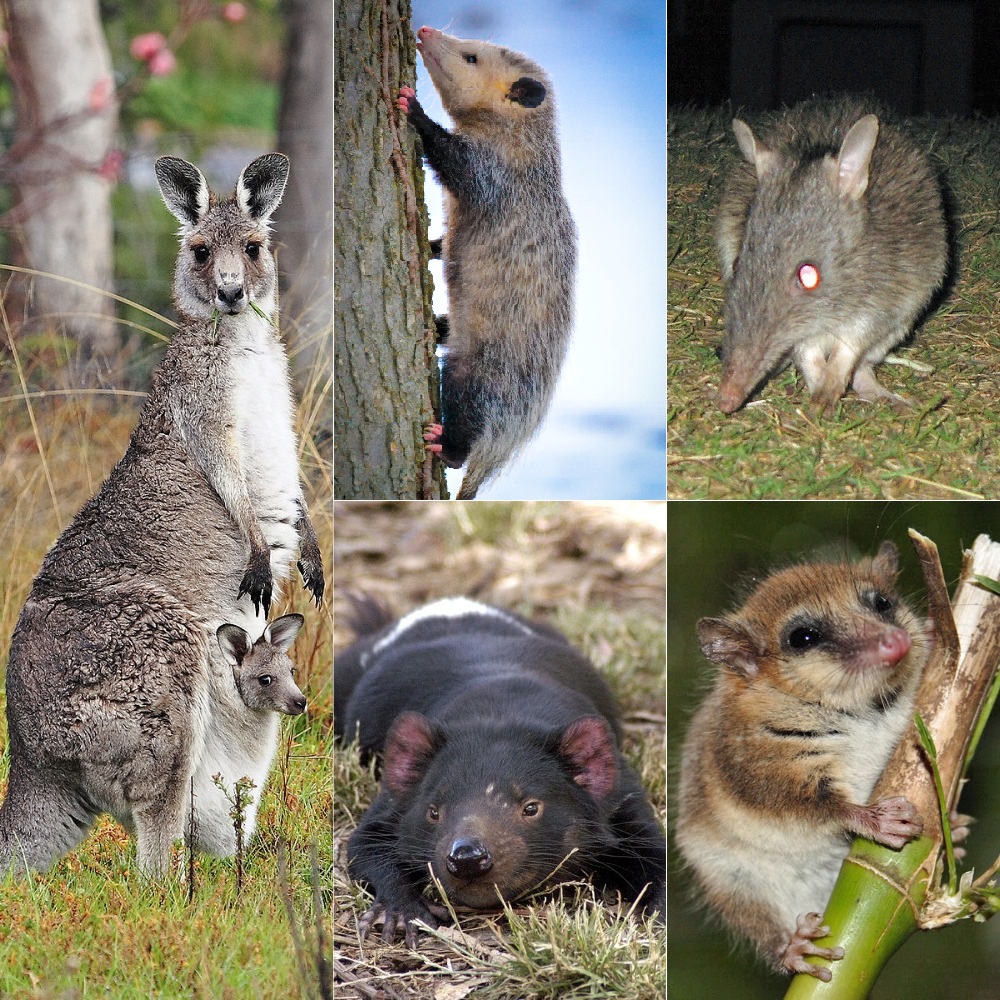
4. Comparative Embryology
Studying how embryos develop in different species can help scientists understand evolutionary relationships. Species with more similar development patterns are often more closely related.
Scientists observe how organisms grow and change after fertilization. In vertebrates, the fertilized egg divides into many cells and forms a ball. This ball continues to change shape and structure as development progresses. At early stages, embryos of different species—like mice, sea urchins, and chickens—can look very similar under a microscope. This similarity suggests they share a common ancestor.
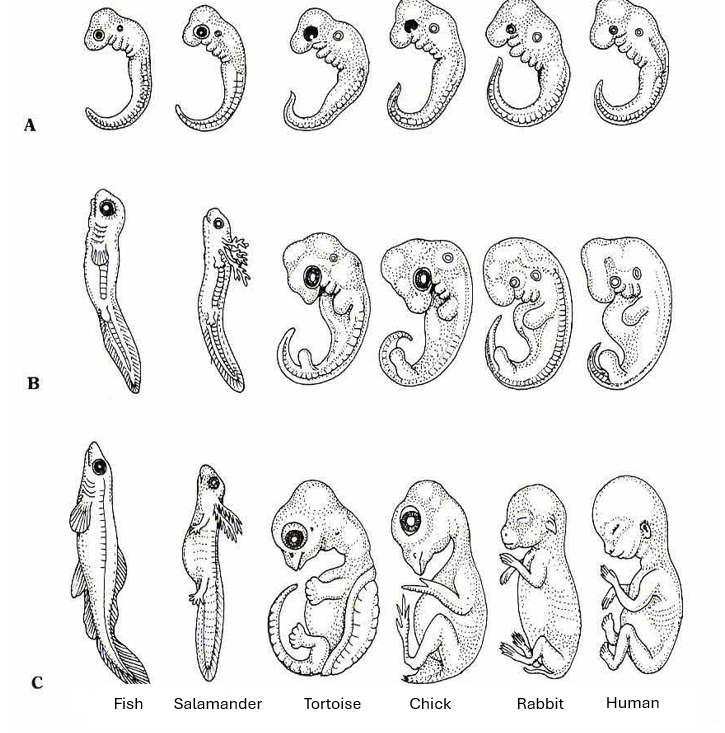
Even though many species start with similar structures during development, these structures often take on different roles in adults. These shared features (homologous structures) point to a shared evolutionary history. For example, embryos of humans, fish, birds, and reptiles all have similar features that later develop into different parts of the body, like gills in fish and parts of the ear and throat in humans.
5. Genetic Evidence
All living things use DNA as their genetic material, and the way DNA is read and used is nearly the same across all life. This strongly suggests that all life shares a common ancestor. In general, the more similar the DNA of two organisms is, the more closely related they are. This matches what we would expect if all life came from a common ancestor and changed over time.
For example, as seen in Figure 1.2.8, humans share about 98.8% of their DNA with chimpanzees, making them our closest living relatives. We also share 90% with cats, 84% with dogs, and 80% with cows. Even more surprisingly, humans share about 60% of their DNA with fruit flies and bananas. These similarities show how all living things are connected through evolution, even if they look very different on the outside.
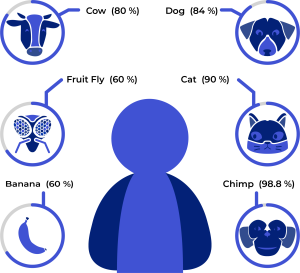
Knowledge Check
Text Description
- Fossils
- Comparative anatomy
- Climate change
- Genetic evidence
- Horses have remained unchanged for millions of years
- Horses evolved from a dog-like ancestor to modern species
- Horses evolved from a species of fish
- Horses first appeared around 100 million years ago
- These animals share a common ancestor
- These animals evolved through convergent evolution
- These animals have analogous structures
- These animals adapted to similar environments
- The similar forelimb bones of humans and bats
- The wings of birds and insects
- The vertebrate skeletal structure in mammals
- The similar leaves of maple trees and cacti
- Wisdom teeth
- Spleen
- Bones in the forelimb
- Hair
- They originated in North America and spread globally
- They evolved in isolation after the continents drifted apart
- They are found only in Africa and Asia
- They evolved after the last Ice Age
- Species with similar embryonic development patterns are likely unrelated
- Species with similar embryos share a common ancestor
- Embryos of all species look identical under a microscope
- Embryonic development does not offer evidence for evolution
- Humans and chimpanzees are unrelated species
- Humans and chimpanzees share a common ancestor
- Humans evolved from chimpanzees
- DNA evidence does not support evolutionary theory
Answers:
- c. Climate change
- b. Horses evolved from a dog-like ancestor to modern species
- a. These animals share a common ancestor
- b. The wings of birds and insects
- a. Wisdom teeth
- b. They evolved in isolation after the continents drifted apart
- b. Species with similar embryos share a common ancestor
- b. Humans and chimpanzees share a common ancestor
OpenAI. (2025). ChatGPT. [Large language model]. https://chat.openai.com/chat
Prompt: Create 8 multiple-choice questions using the following content
“11.3 Evidence of Evolution” from Biology and the Citizen by Colleen Jones is licensed under a Creative Commons Attribution 4.0 International License, except where otherwise noted. Modifications: Edited and reworded; Added additional images and knowledge check.
“Evidence of Evolution” from Introductory Biology: Ecology, Evolution, and Biodiversity by Erica Kosal is licensed under a Creative Commons Attribution-NonCommercial 4.0 International License, except where otherwise noted. Modifications: Edited and reworded; Added additional images and knowledge check.

